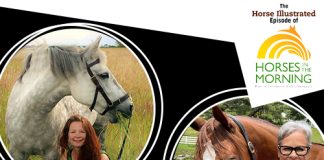Even though horses don’t speak our oral language, they’re communicating with us all the time. However, most of us overlook their whispers until they’re forced to “shout”—with kicking, spooking, biting or other unwanted behavior. Read on to find out the reasons for these horse behavior problems.

Cinchy/girthy
These horses express their displeasure with the saddling process by snaking their heads around, pinning their ears or exhibiting other signs of grumpiness.
Possible causes:
- poorly fitting saddle
- wrinkles under girth
- sore back
- rib/sternum pain
- anticipation of pain while being ridden
“At a recent clinic, we had a horse who was very cinchy, would buck saddles off and so on. I was running my hand lightly along the sternum, and I felt a rib pop. This horse was having all this trouble with bucking because he was in so much pain. He could hardly stand to be cinched up.”
Mouth/bitting issues
Horses that aren’t comfortable with the bit may chew excessively, open their mouth, root on the bit, try to pull the reins out of your hands or throw their heads.
Possible causes:
- dental problems
- mouth problems/injuries
- poor saddle fit
- feet that aren’t balanced
- bit shape not compatible with horse’s mouth conformation
“I have a young horse that was rooting on the bit. Right after that, she developed a sore back. I had three different people work on her and the back pain kept returning. Finally, an equine dentist found a tooth near the back of her mouth that was causing her a lot of problems. It turns out she was compensating through her whole body for the pain in her mouth.”
Troubles picking up a certain lead/troubles going downhill/difficulty standing for the farrier, etc.
Horses with these issues may not have been taught what you consider “correct” behavior. For example, don’t assume a horse has been trained to stand on three legs while being trimmed or shod. Horses may also be trying to tell you they have a physical problem.
Possible causes:
- sore back
- arthritis
Horses often can be off without being obviously lame. One way to check for subtle pain is to evaluate the stride. “Have someone stand the horse square in front of you,” explains Mark. “Notice the sacrum area and where the points of the hip are. This is his ‘neutral’ position. Next, have the person lead the horse away from you at a walk.” Ideally, each hip will rise and fall by the same amount. “If one hip rises or falls more than the other, then it’s likely the horse has pain in his lower back or his hip,” says Mark.
Signs of Worry
If a horse is really worried about something, he’s honestly afraid. “That’s where a wreck usually comes in—when we ignore the fact that our horse truly is worried and we force him to deal with it,” says Mark.
Some signs of worry:
- Tense body
- Alert ears
- Head held high
- Disconnecting mentally
- Holding breath
“One of my young horses was afraid of traffic cones in the arena. So, instead of making a big issue out of the cones, we pretty much ignored them,” shares Mark. “In about 15 minutes, he was making the decision to make his way over to the cones.” His fear had been replaced by curiosity. “Before too long, I’d taught him how to push the cone over with his nose and kick it back upright with his hoof. And just a few minutes earlier, he’d been terrified by the cones.”
Words to the Wise
“When you’re dealing with what you think is a training or behavior issue, step back and look for everything except a training issue,” says Mark. “Look at poor saddle fit, dental problems, a bit that doesn’t fit that horse’s mouth conformation, shoeing and hoof balance problems, back or neck problems, and so on. More often than not, the ‘training issue’ turns out to be something else, and when the cause is found, the training issue goes away.”
For more information on Mark Rashid’s philosophies, see www.markrashid.com.
Further Reading
When Horses Act Dangerously







Good information, thank you
great article!
that helps a lot!
good info
Great article!
Very helpful.
Good article. I’d like to see more articles like this, on ground training and general behaviour problems, rather than just riding. Training a good riding horse is done from the ground up
Good article, im dealing with spooking problems with my horse I dont know what im doing wrong but he is spooking at different things but im dealing with it a day at a time I refuse to fall off again bcause I was readjusting myself and he took off running I wasnt prepred then he finished it with a bunny hop and I flew off
i have a 8yr. old TB that started to be a bully in the Pasture he is chasing horses that do nothing to him he also starts acting up while riding had him for 3 years and he never done anything to this nature he had chiro 3weeks ago and been checked over nothing out of the norm any advise would be greatly appreciated thank you Petie Rogers
when my horse doesn’t want to go to where I am trying to get him to go he backs ups and keeps backing up…he refuses to stop…I have no control until he decides to stop…
Interesting article with good examples. It’s so important for people to realize that a horse’s behavior doesn’t always mean that he’s being disobedient or purposely misbehaving.
Melissa, I too have a horse who backs up quickly when he is unconfident. I can however control him with a one rein stop and thought perhaps you could try it. He cannot continue to back up when his head is pulled to one side and his hind quarters are disengaged.
Great things to keep in mind.